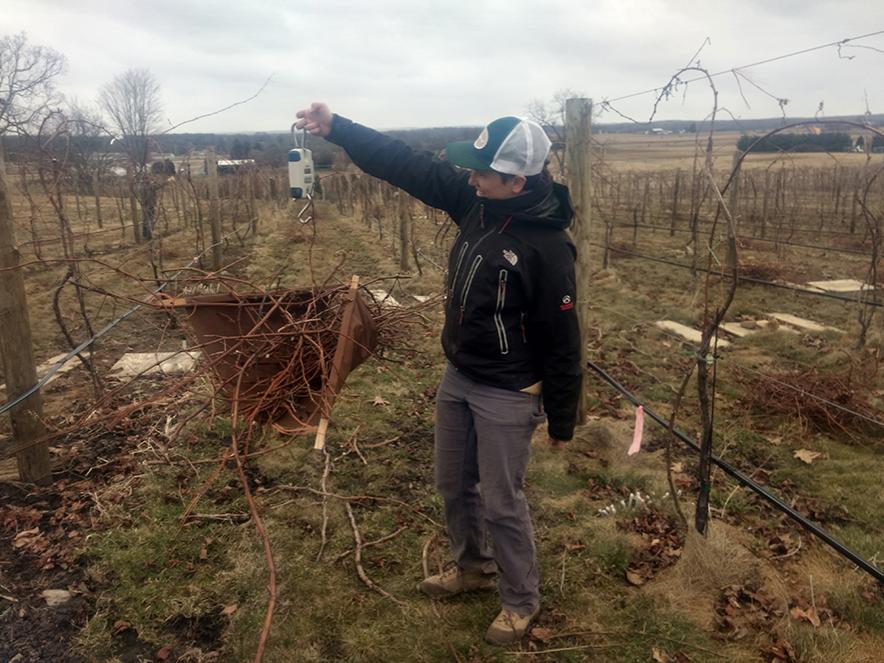
The practice allows growers to avoid the use of herbicides to suppress weeds, save labor costs by not having to reduce excess vine growth and protect soil from severe rainfall events, she explained, adding that planting under the vines is a new approach that uses competition from a cover crop to decrease the vegetative growth on vines.
“If there are a lot of big leaves growing around clusters of grapes, it traps moisture and prevents wind flow, creating a microhabitat that promotes disease,” she said. “By having less vegetative growth, you also get more sunlight on the grapes, which is important for developing important aspects of wine chemistry.”
Centinari’s research group in the College of Agricultural Sciences planted the experimental vineyard at the Larson Center in 2015 and has been experimenting with cover crops and grape production since. In recent years, she has become especially interested in below-ground competition and how grape vines respond, especially related to excessive vegetative growth in vines.

Suzanne Fleishman, who spearheaded the most recent study as a doctoral student, noted that the work shows that some grapevine rootstocks respond well to being paired with cover crops and provide ecosystem services that will benefit growers.
She pointed out that in regions like the U.S. Northeast — where soils are generally fertile, extreme weather events are worsening and growing more frequent, and excessive vegetative growth on grapevines is a common problem — planting cover crops under mature vines makes sense as long as the right cover crop species are carefully matched with the grower’s production goals.
“Producing wine grapes is very labor intensive, and it’s increasingly difficult to find skilled vineyard labor, so if we can reduce the need or time it takes to prune leaves or shoots, that’s a significant benefit,” said Fleishman, now a postdoctoral scholar working with the U.S. Department of Agriculture. “There are many different cover crops and several different rootstocks offering varying degrees of vigor, so growers could potentially choose a combination that is just right for their growing conditions. However, to aid growers in making this type of decisions, we need to understand the cover crop and rootstock root interactions below ground.”

In findings recently reported in Agriculture, Ecosystems and Environment, the researchers reported that cover crops growing under grapevines reduced vegetative growth between 13% and 30% across all five years of the study, with a trend of more substantial reductions in the first two years. In contrast, grape yield was reduced in only three of the five years, between 9% and 25%, depending on the rootstock.
Importantly, neither cover crop nor differences in rootstock vigor resulted in relevant or consistent changes in fruit chemistry during the study, according to the researchers. Overall, they found that in a relatively fertile, young vineyard, combining a lower vigor rootstock with a perennial, under-vine cover crop imparted substantial agroecosystem services in comparison to the more common practices of using a medium vigor rootstock and spraying herbicide under the vines.
Grapevines have some of the deepest root systems of any crop, Fleishman pointed out, so to determine how the two rootstocks responded to the cover crop, the team used soil coring to 3- foot depth throughout the vineyard in 2017 and 2019.
“By separating the cores into distinct soil depths, extracting and scanning the roots, and measuring the root length, the team could see how the root distributions shifted over time, Fleishman said. “Linking these root system shifts to soil properties and aboveground grapevine growth was critical to explaining how the cover crop increased agroecosystem services.”

These services included improved crop load — the ratio of fruit to vegetative mass, increased soil phosphorus availability, increased deep soil water content, added 50% more carbon to shallow soils, and presumably decreased labor and other costs associated with vineyard maintenance.
As promising as these findings appear, Fleishman said, studies spanning a decade or more are needed to further clarify whether these ecosystem services persist, accumulate with time, or if competition from the cover crop eventually leads to unacceptable decreases in vine nutrient status, growth and production.
David Eissenstat, emeritus Penn State professor of woody plant physiology; Grant Hoffer, a recent graduate from Penn State with a bachelor’s degree in plant science; and Don Smith, research technologist, contributed to the research.
The research was supported by the U.S. Department of Agriculture’s National Institute of Food and Agriculture and the Pennsylvania Wine Marketing Board.
Source : psu.edu